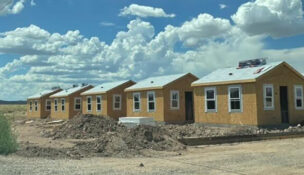Arizona’s unemployment rate at historic lows, jobless benefits won’t be cut
Howard Fischer, Capitol Media Services//June 15, 2023//
Arizona’s unemployment rate at historic lows, jobless benefits won’t be cut
Howard Fischer, Capitol Media Services//June 15, 2023//
The state’s unemployment rate remains at historic lows.
But those Arizonans who do find themselves out of work through no fault of their own won’t see their benefits cut, at least not this year.
A new report Thursday from the Office of Economic Opportunity shows the seasonally adjusted rate for June at 3.4%. No lower figure has been registered in the state since the current method of computing the statistic was instituted in the 1970s.

The report comes just days after state lawmakers narrowly defeated a proposal by Sen. Steve Kaiser, R-Phoenix, that would have sharply cut the length of time that Arizonans who are laid off can collect jobless benefits.
Kaiser contends the current system, which provides benefits of up to 26 weeks for those fired or laid off without case, removes the incentive for those out of work to go out and look for new employment.
He sought — and got the state Senate to approve — a graduated scale that based the eligibility period on the statewide unemployment rate. And at current levels, his SB 1167 would have ended benefits after just 12 weeks.
But two House Republicans aligned themselves with Democrats opposed to the bill, denying Kaiser the 31 votes he needed for approval.
One of them, Rep. David Cook of Globe, told Capitol Media Services on Thursday that a big flaw in what Kaiser was pushing was that the length of benefits would be based on that statewide unemployment rate — a rate that, because of where most of Arizonans live and work is linked heavily to economic conditions in the Phoenix metro area.
“If I lost my job in Chandler I could drive to Queen Creek,” he said.

“If I lost my job in Mesa I could go to Tempe,” Cook continued. “Tempe, I could go to Phoenix. Or Phoenix, I could go all the way to Mesa.”
That, said Cook, isn’t true for residents of rural areas. And even now, in a time of generally low unemployment rates, both statewide and nationally, the picture varies across Arizona.
Maricopa County, for example, has logged jobless rates below 3% for four of the past five months.
In Pima County, by contrast, the percentage of people listed as unemployed, meaning they are actively seeking work, has been running about a half point higher.
And in Gila County, where Cook lives, the latest unemployment rate was 4.1%.
That’s still low. But it’s also historically proven quite volatile.
Even disregarding what happened during Covid, Gila County hit a 14.1% unemployment rate in January 2010. A decade ago, it was 9.3%.
Much of that is because the employment situation in not just his county but several others in Arizona is closely linked to copper, both mining and smelting.
“And when the mining industry lays people off, it takes a long span for it to recover,” Cook said.
He said that Kaiser’s legislation does not take into account that there simply are not nearby jobs that people can pick up waiting to be called back to work.
More problematic, Cook said, is what happens if those laid-off workers, facing a cutoff in their benefits, decide to pack up and move elsewhere.
“If the mining companies lose those experienced workers, then they spend thousands and thousands of dollars on training new people that have no mining experience,” he said.
And there’s something else.
Cook said those unemployment benefits are not paid for from state tax funds. Instead, he said, it’s actually a form of insurance.
Payments come from a special fund which is financed by a levy paid by employers on the first $8,000 of each worker’s salary.
The actual tax rate is based on how often a company’s workers end up being found eligible for benefits. Rates range from as low as 0.07% for firms with low usage to as high as 18.78% for companies which have a high number of employees who are laid off or fired for no reason of their own.
Thursday’s new statewide report shows generally good employment conditions — especially for workers. And it’s not just the record low unemployment rate.
The most recent figures show that the “openings rate” in Arizona was 5.9%. That reflects the number of positions that are not filled.
And Doug Walls, the state agency’s labor market information director, said that figure is higher than pre-pandemic levels.
By contrast, the hiring rate — the rate at which employers were able to fill jobs — was just 4.4%
“That’s a sign that employers are still understaffed and looking for labor,” Walls said.
One bit of fallout from all of that is that Arizona companies are having to pay more to fill those slots.
The state’s wages rose 5.6% in the past year, compared with just 3.6% for the rest of the nation. Still, even at that, the average hourly wage in Arizona is $31.61 versus $33.37 nationally.
But not all sectors of the Arizona economy are growing.
One big loser was in warehousing and transportation.
“This was an industry sector that had benefited from the impacts of the pandemic,” Walls explained.
“Consumers turned to purchasing goods.”
More to the point, he said a lot of those purchases were made online.
“More traditional retail businesses also had closed in-person sales,” Walls explained. And that left the companies that could store and deliver those ordered goods.
Now, he said, these companies don’t need as many workers. But Walls said that the industry still has more people employed than it did before Covid.
Different factors are affecting other sectors of the economy that shed jobs last month. And at least some of that is tied to both inflation and the efforts by the Federal Reserve Bank to curb it with what has been a series of hikes in interest rates.
So, for example, the state’s financial activities sector shed 3,800 jobs between April and May. And half of those were among credit unions, mortgage and other loan brokers and commercial banking as higher borrowing costs meant fewer qualified applicants.
Then there’s the closely related construction sector which lost 1,300 jobs in the past month. By contrast, it normally adds about 1,000 jobs between April and May.
And much of that has been tied to demand for housing which, in turn, is affected by the cost of mortgages.
Walls pointed out that there was pretty much a consistent and steady increase in permits for new homes from 2010 until the middle of 2022. It plummeted by nearly two thirds earlier this year. And while there has been some recovery, Walls noted that the number of permits is still 17% below what it was a year earlier.
Still, he said, there are some optimistic signs. One of the biggest, Walls said, was the decision Wednesday by the Fed to pause further interest rate hikes, at least for the time being.
That, he said, “should be a positive indicator for those looking to purchase a home.”



















